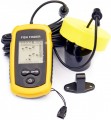— Screen size. Diagonal screen size in inches. The
larger the screen, the more information can be displayed on it and the more detailed this information can be. On the other hand, this parameter noticeably affects the dimensions of the device, and large screens are expensive, especially since you need the appropriate resolution for normal image quality (see below).
—
Touch. The presence of a sensor in the design of the display. This feature allows you to control the device by touching the icons on the screen — similar to how it is done in smartphones and tablets. Touch control provides more options than the classic one, using buttons and switches, besides it is more visual — however, such devices are more expensive.
— Display resolution. Display size in dots (pixels) horizontally and vertically. The higher the resolution, the more detailed image the screen is able to produce, the smaller objects can be clearly displayed on it and the more comfortable viewing. At the same time, the specificity of echo sounders is such that too high resolution is not required even for high-end models: for example, modest by the standards of smartphones or tablets 640x480 with a 5" screen are considered quite sufficient even for an advanced device.
— Colour. The ability of a screen to display colours. In this case, the simplest division is used:
Monochrome.... Displays that display information only in shades of one colour. Theoretically, the main colour can be any, but in this case, the vast majority of monochrome screens are black and white. Their advantages are low cost and energy consumption, as well as good visibility in the sun; at the same time, such an image allows you to work with quite a variety of types of data, which is enough even for very advanced echo sounders (see "Type"). However, this variety is not as wide as for colour displays, as a result, for chartplotters (see ibid.), such an image is not suitable — if it is impossible to display different colours, some of the important information on the maps is lost.
Coloured. Screens capable of working with multiple colours. The variety of colours can be quite small, but the image still turns out to be more informative than black and white: different colours can indicate different depths on the map, water temperature changes, etc. Due to this, this type of display is found in all types of navigation devices (see above). Its main disadvantage can be called a higher cost than that of monochrome screens.
— Backlight. The screen has its own backlight system. This feature makes the display independent of ambient light and allows you to see the information on it even in complete darkness. At the same time, the backlight increases power consumption, which is important during long-term operation from an autonomous source (for example, a boat battery). Therefore, it can be turned off.The presence in the design of the device protection against dust and moisture.
This function is realized due to the body of the appropriate design, which prevents the ingress of moisture and dirt on the sensitive elements of the device. It is practically mandatory for modern fish finders and chartplotters (see "Type"), as such devices are originally designed to work near water, where the likelihood of splashing is very high. At the same time, note that the specific degree of dust and water protection may be different.
The IP standard is often used to describe it. The classic designation according to this standard includes two digits, one of which corresponds to the degree of protection against dust and foreign objects, the other against moisture (IP54). Here are the most common options for the first digit in modern devices:
- 4 — protection against objects more than 1 mm (most wires, tools, bolts and nails, etc.)
- 5 — full protection against solid objects, dust resistance (some dust may get inside, but it does not interfere with the satisfactory operation of the device).
- 6 — full protection against dust ingress into the case.
For the second digit, the options are:
- 4 — resistance to water splashes from any direction;
- 5 — resistance to water jets of medium power from any direction (protection against powerful splashes during storms);
- 6 — resistance to powerful water jets from any direction (protection agains...t sea waves)
- 7 — resistance to complete immersion in water to a shallow depth and for a relatively short time — but not less than half an hour to a depth of 1 m.
- 8 — resistance to prolonged immersion in water to a depth of more than 1 m. Possibility of submerged operation.
A specific option is a marking with one number and the letter "X" in place of the second — this means that certification has not been carried out for this parameter. In the case of fish finders and chartplotters, "X" is usually put first — for example, IPX4. This is due to the fact that dust resistance for this class of devices plays a secondary role, and many manufacturers prefer not to spend money on certification of this parameter.
It should also be said that dust and moisture resistance is indicated for the main unit of the device placed on board; external sensors that are lowered into the water during operation must, by definition, be waterproof, so they are not discussed in this case.

